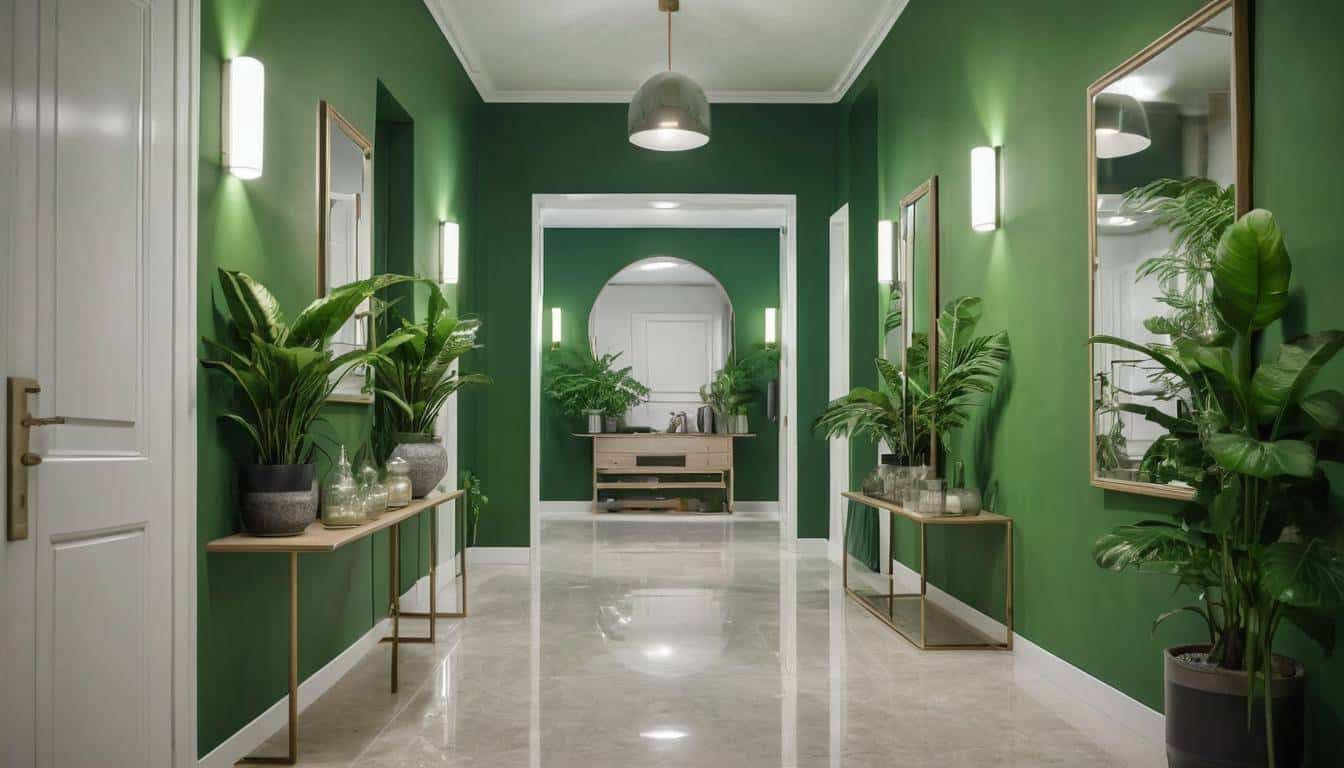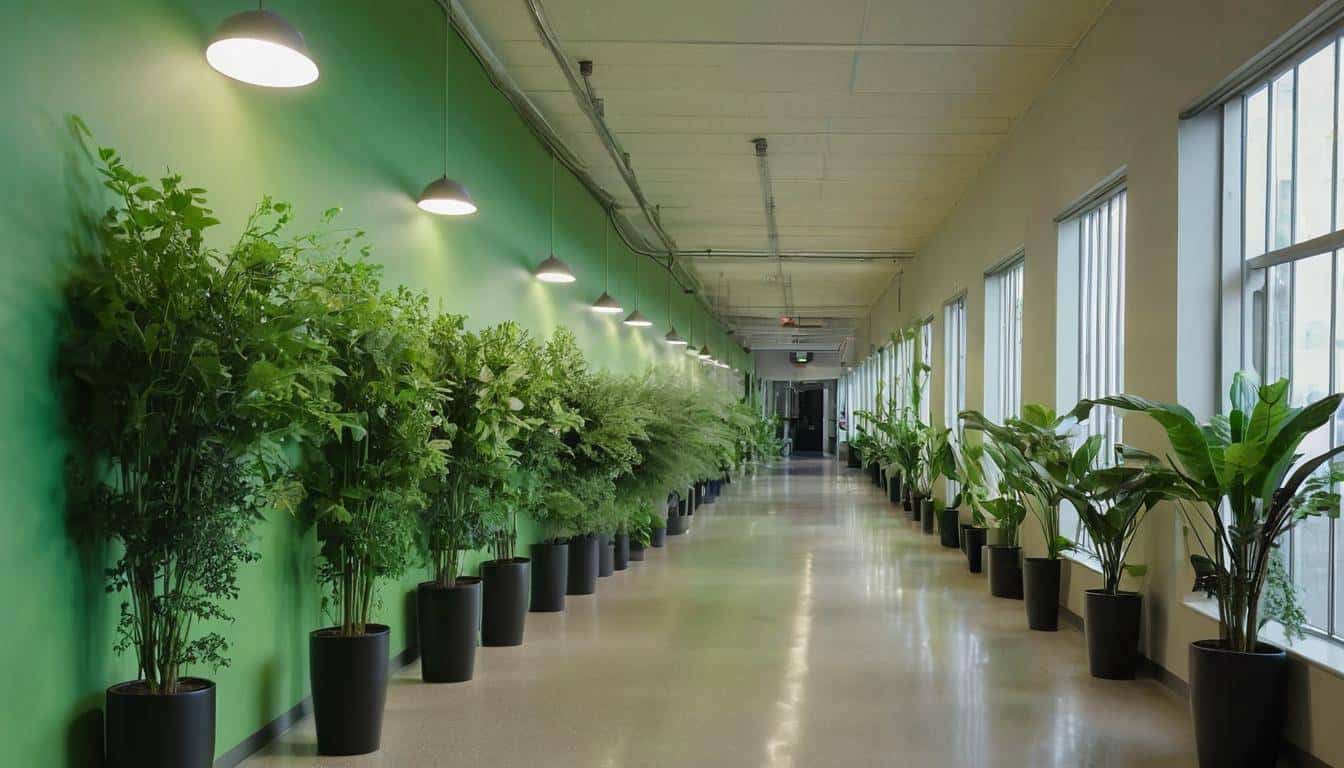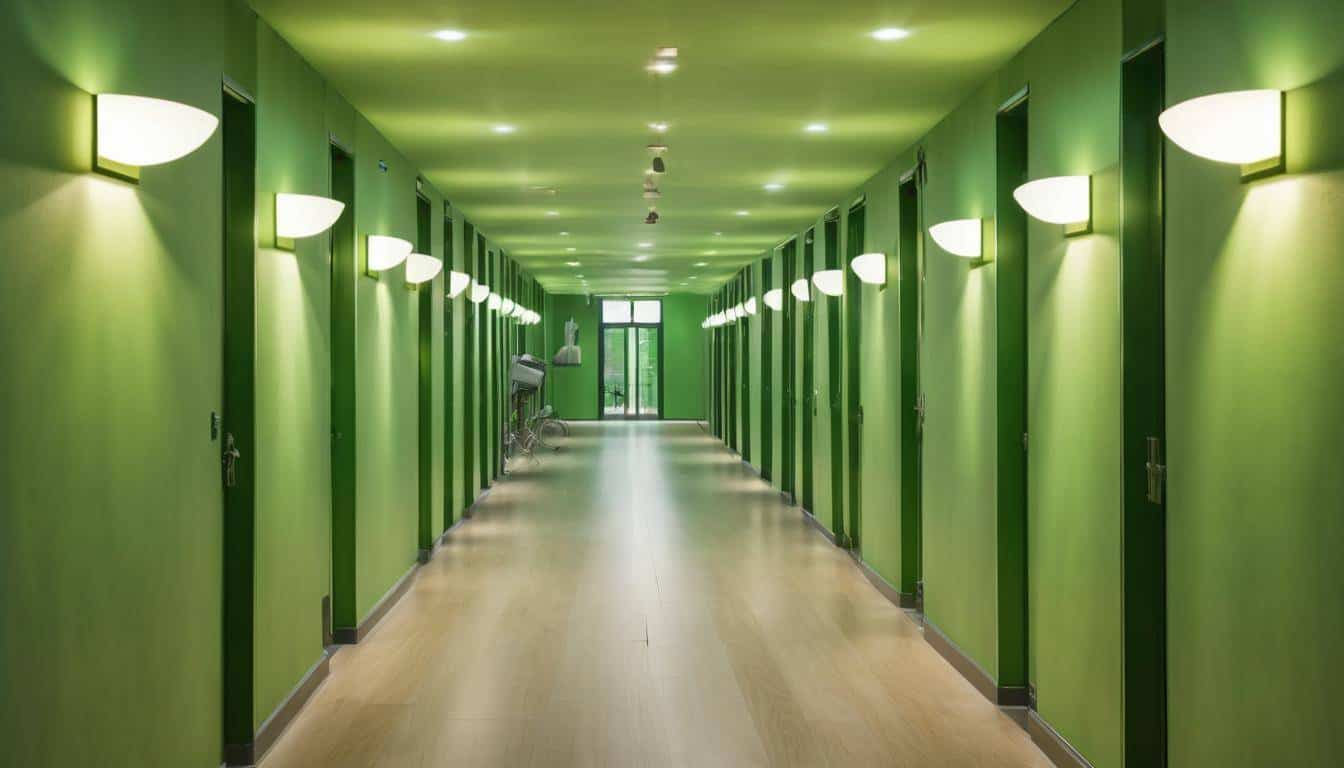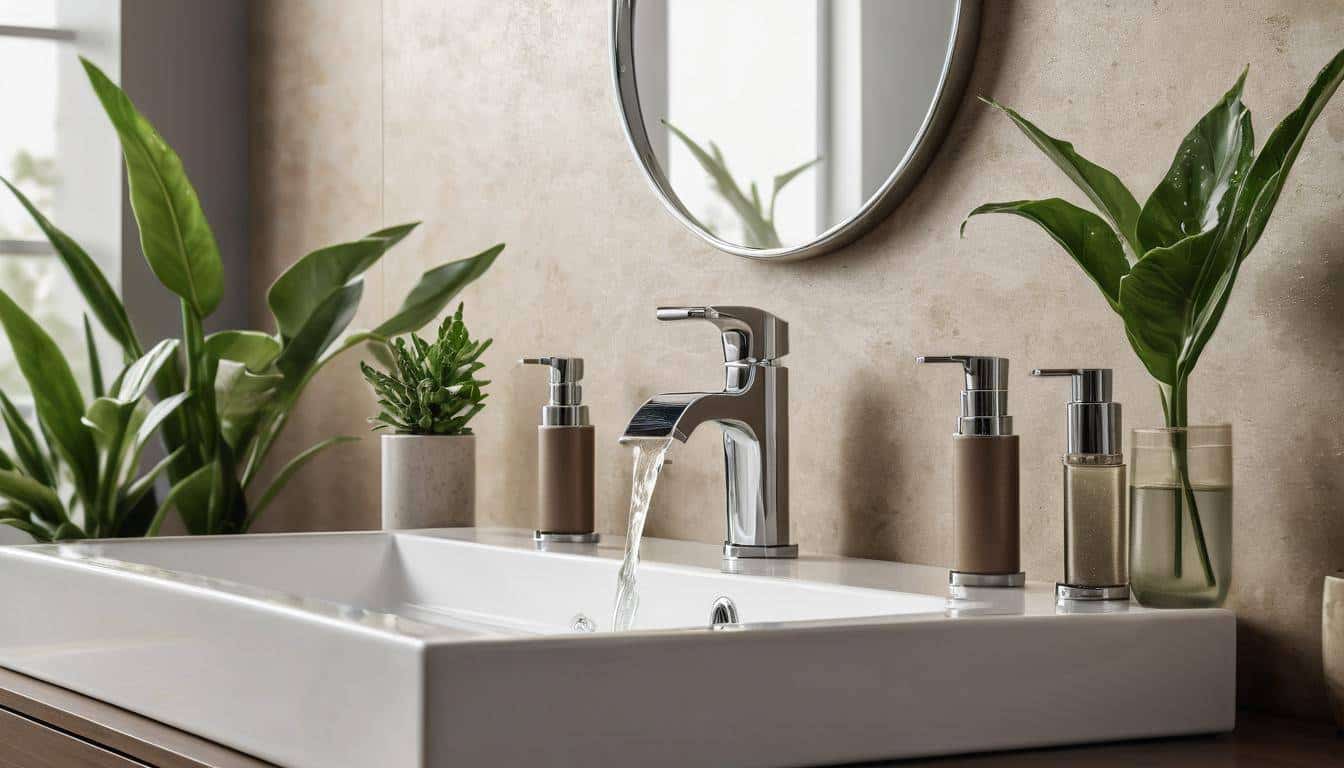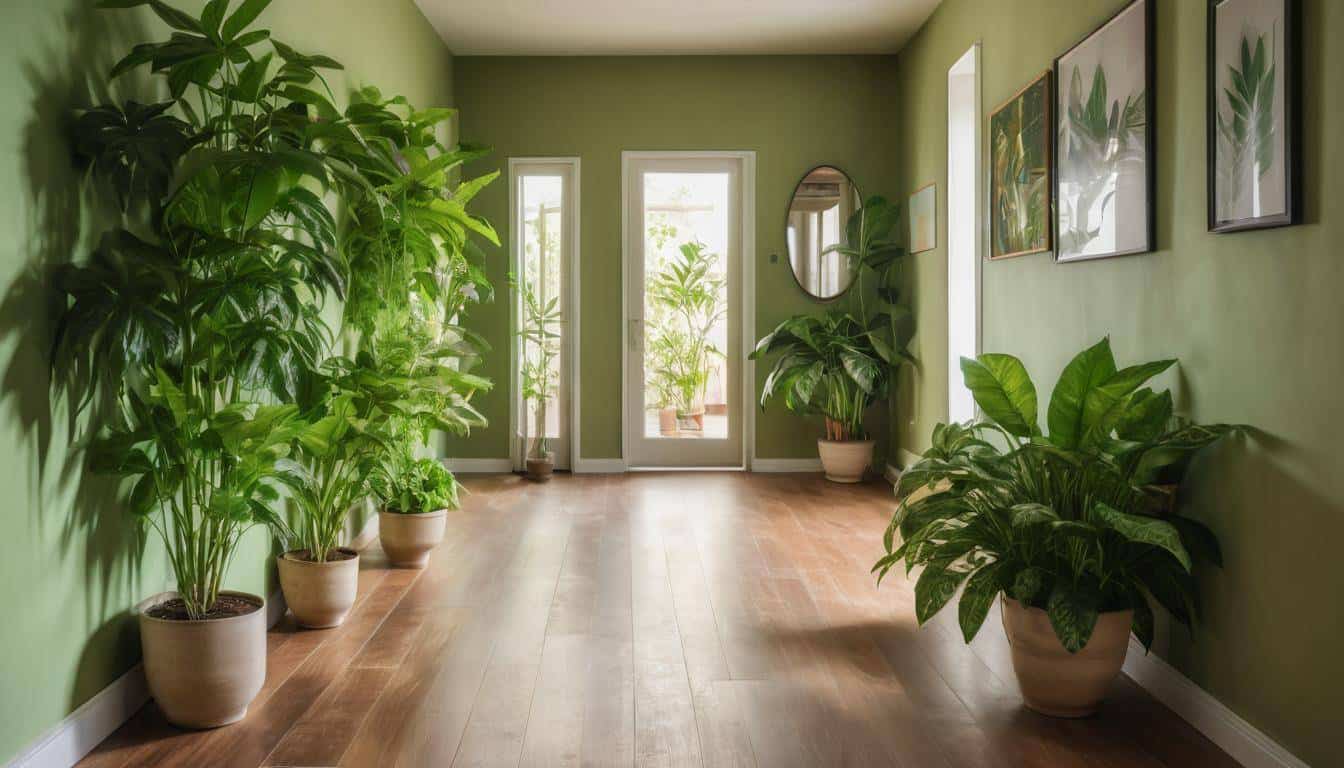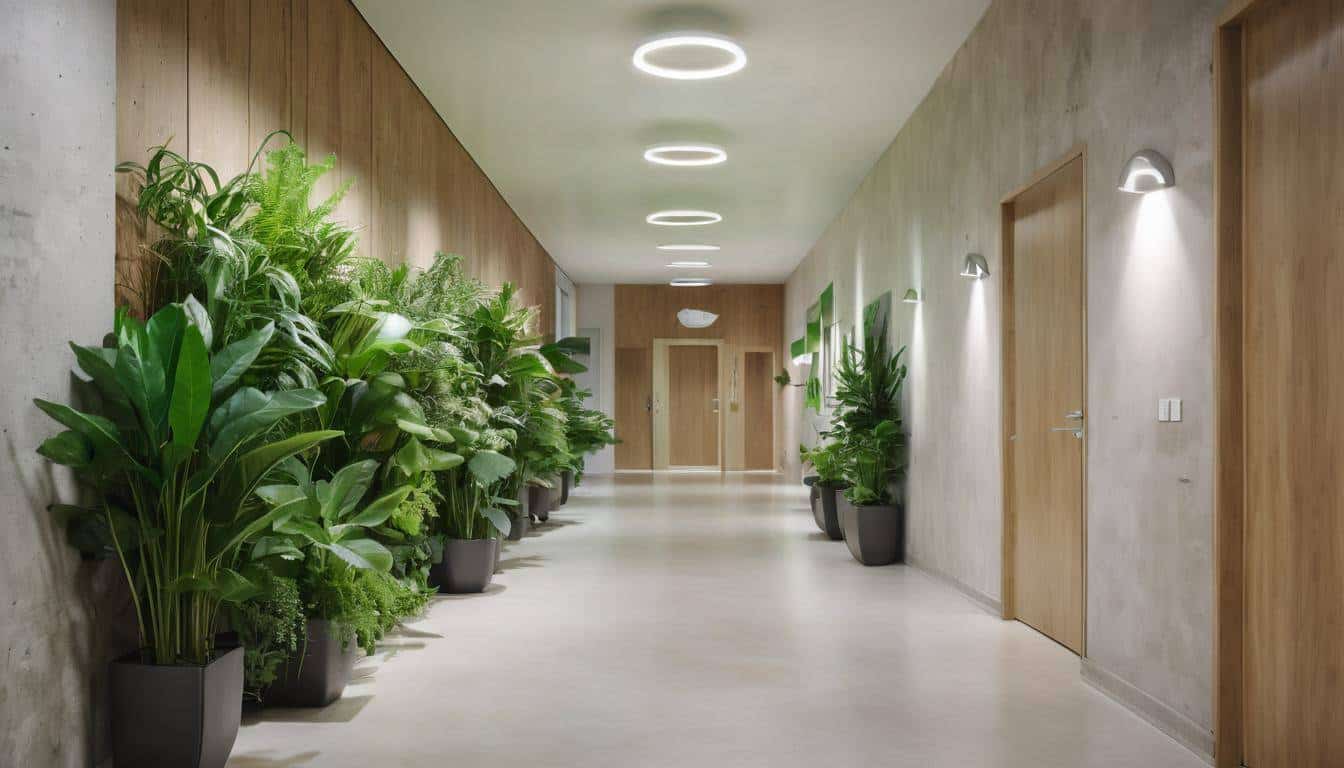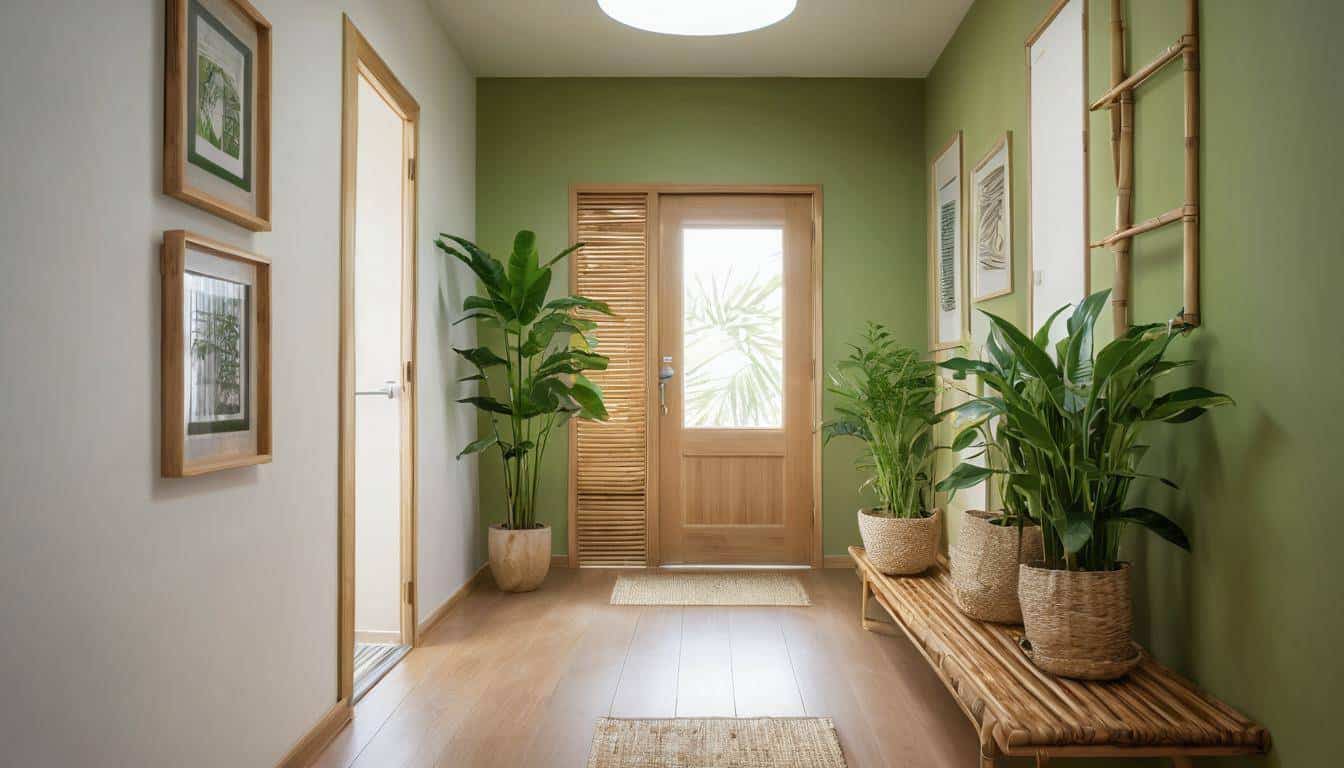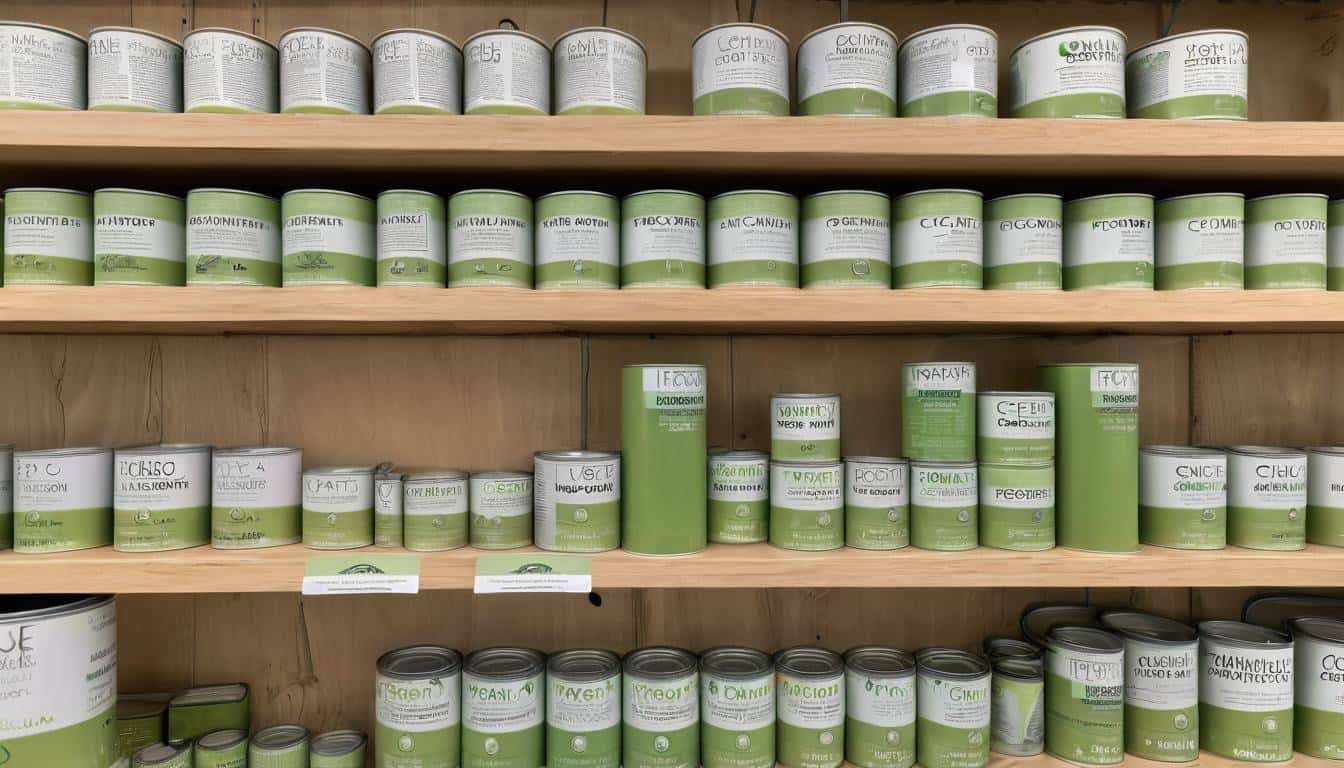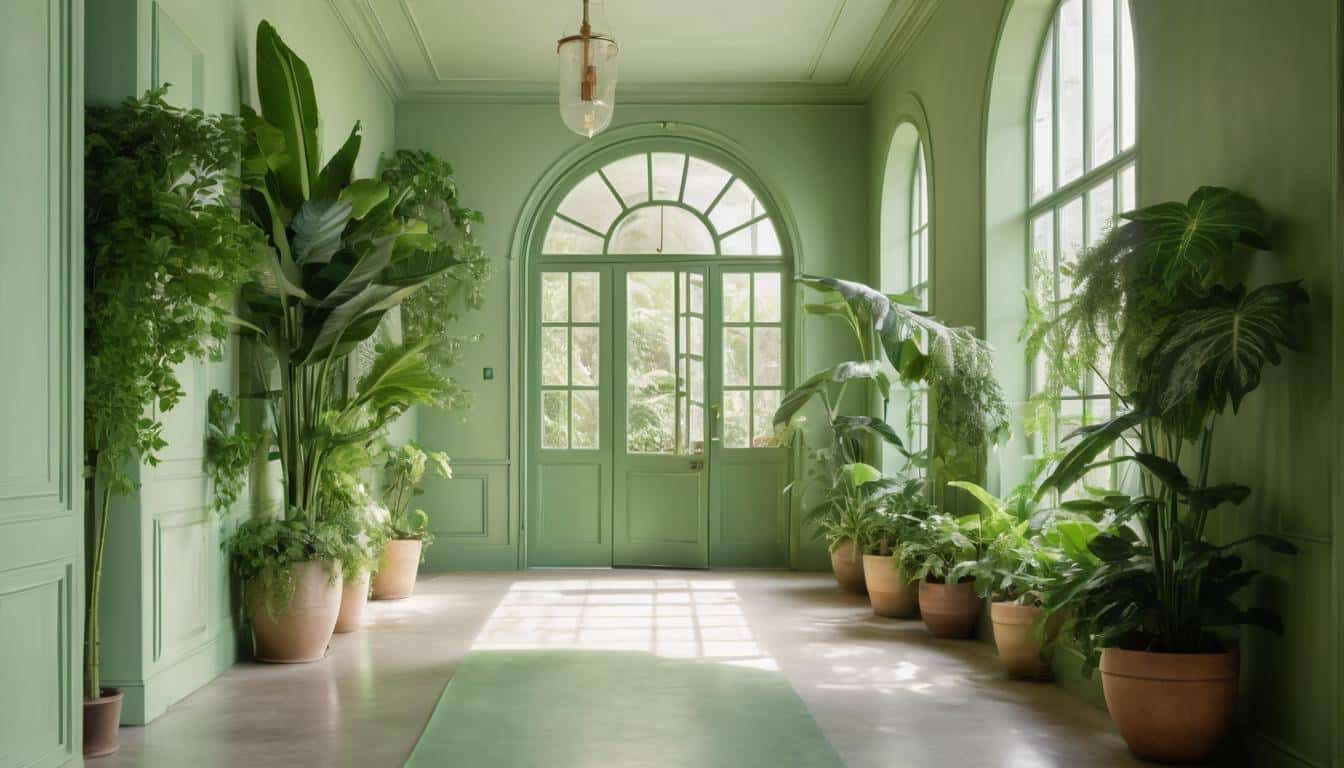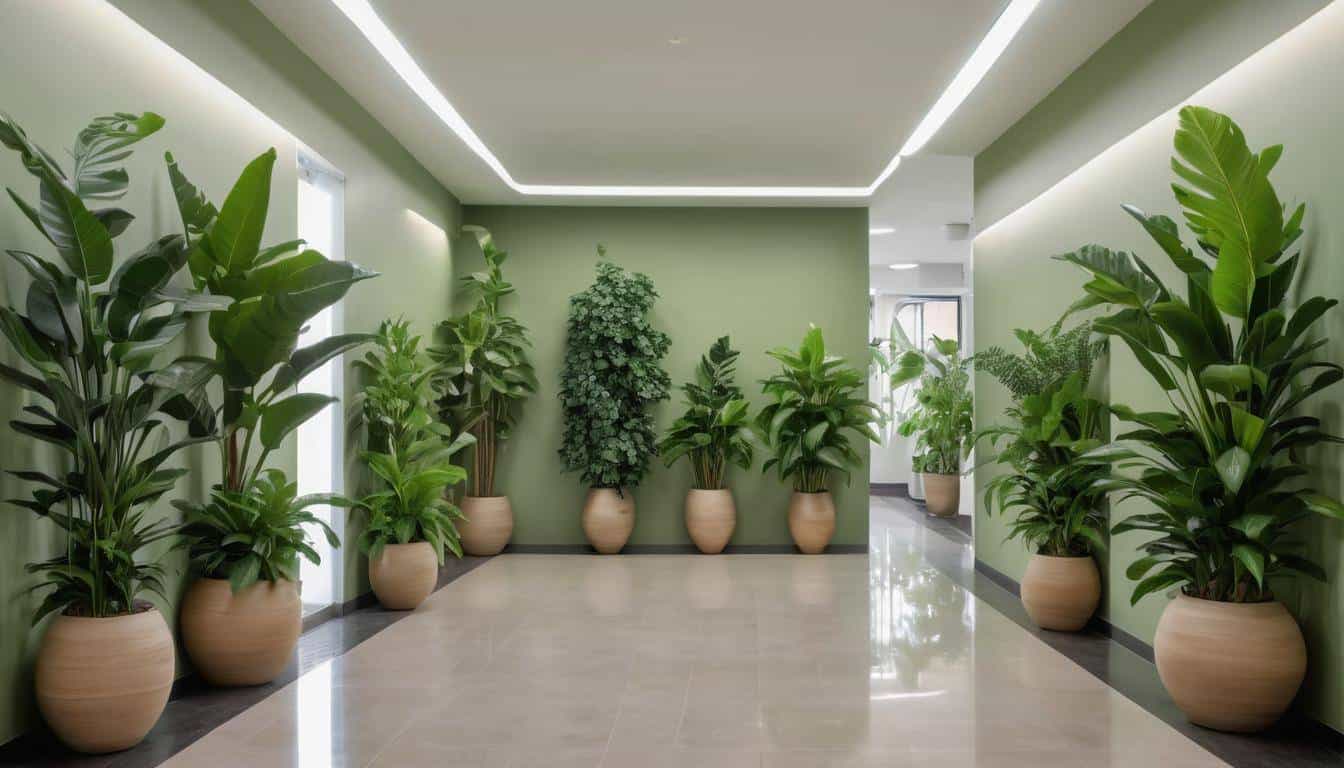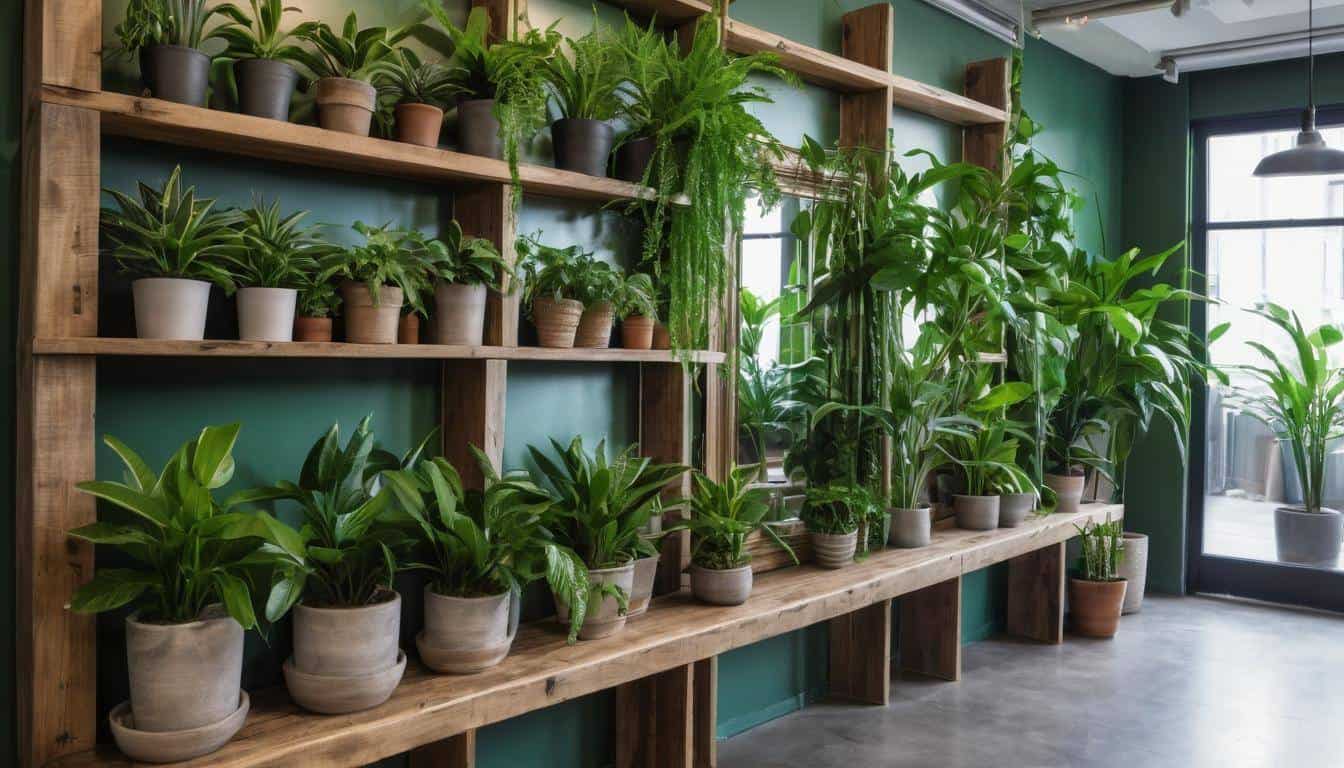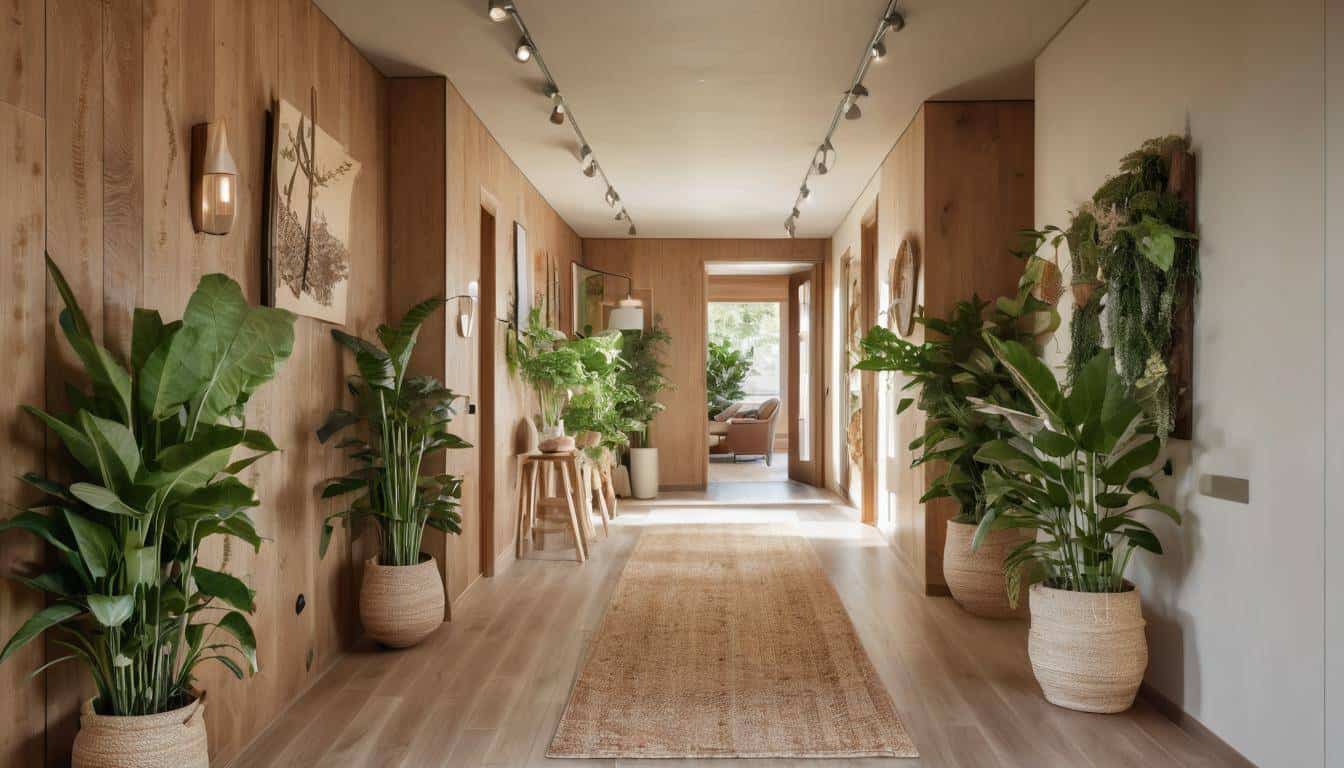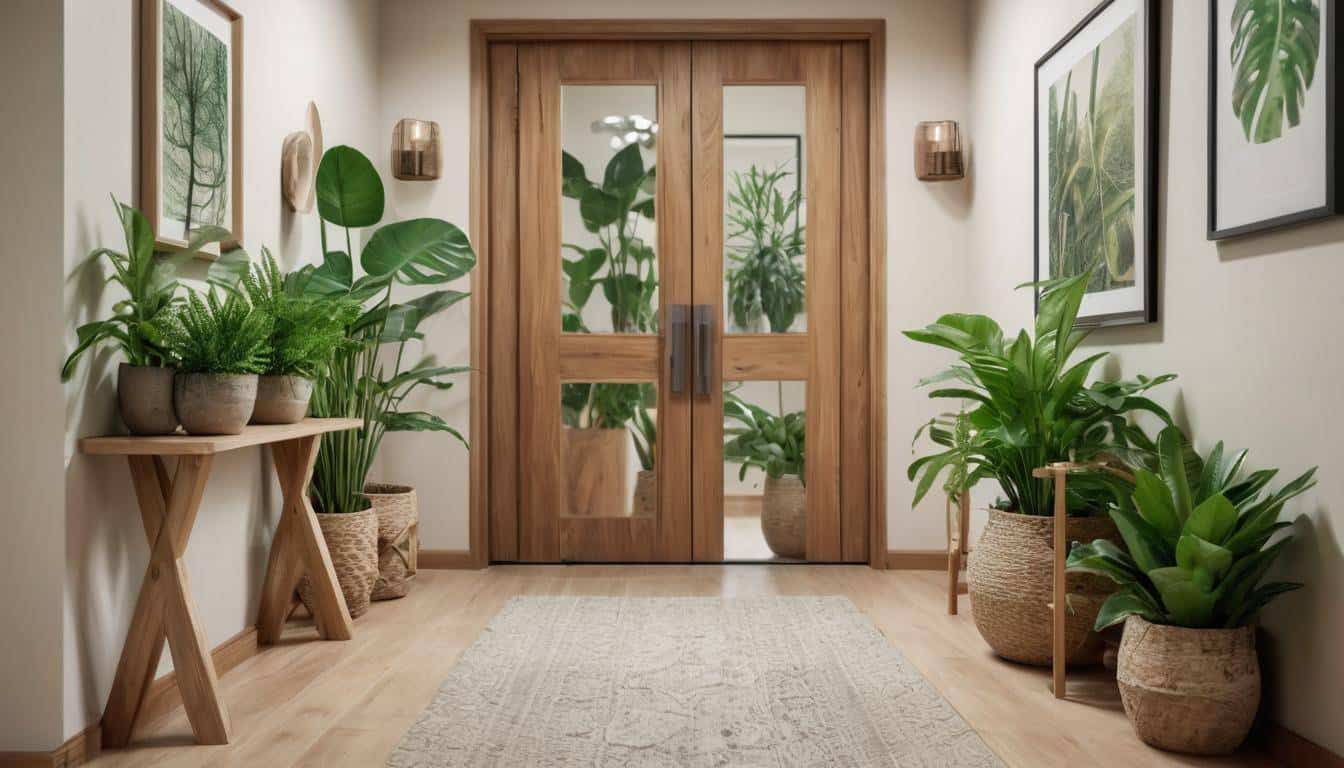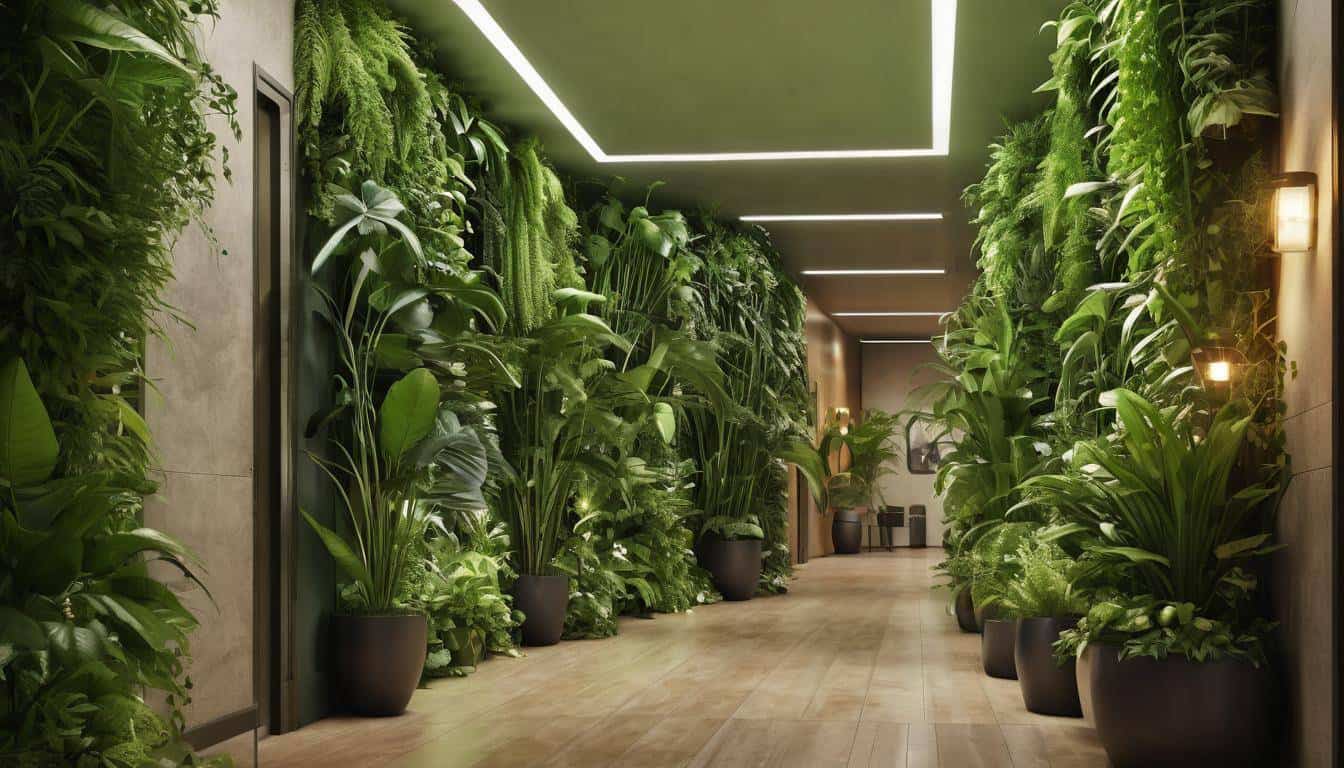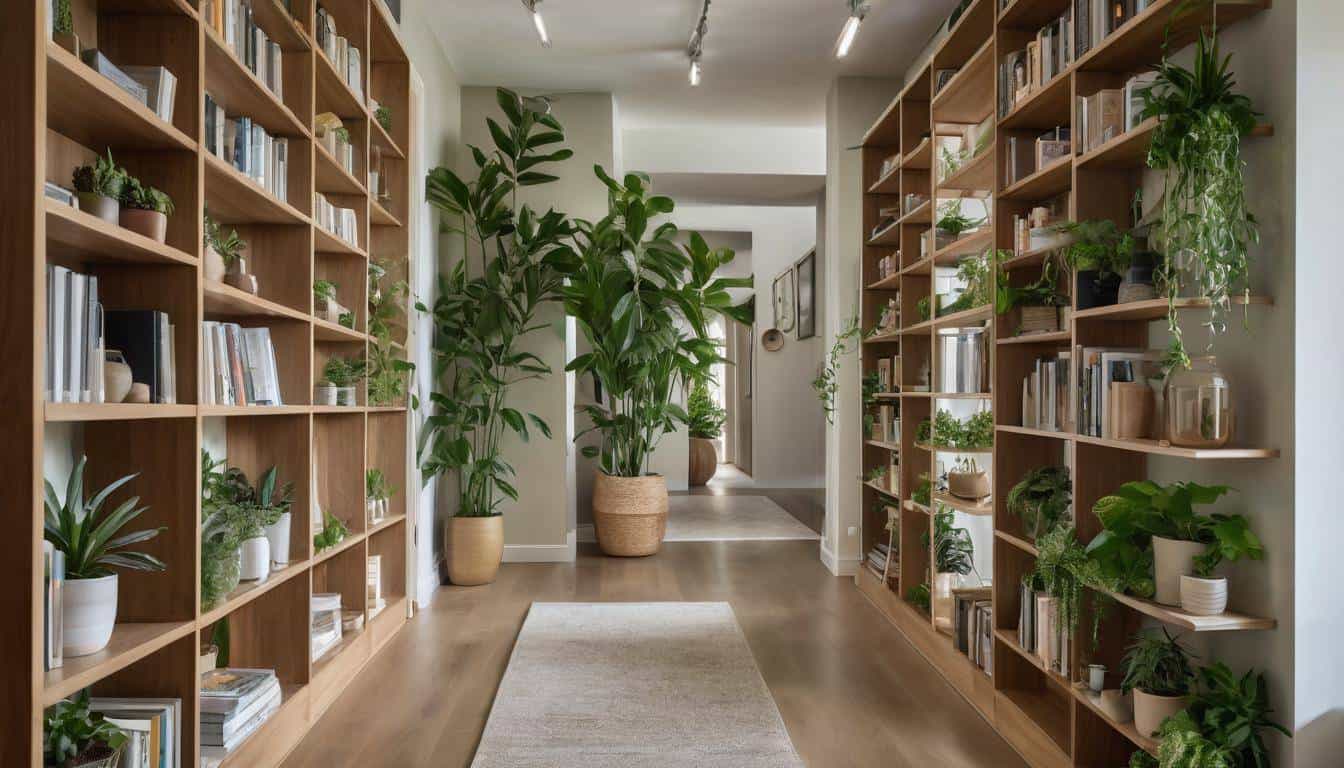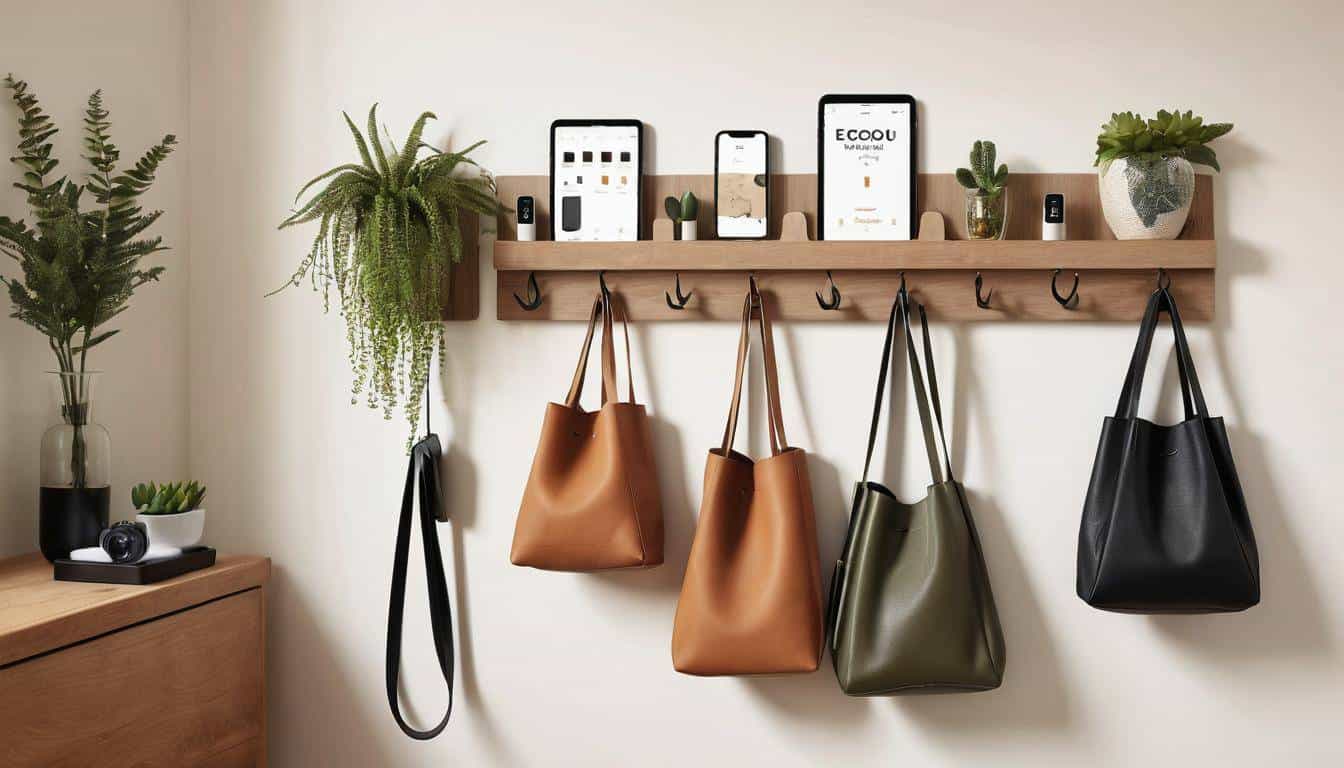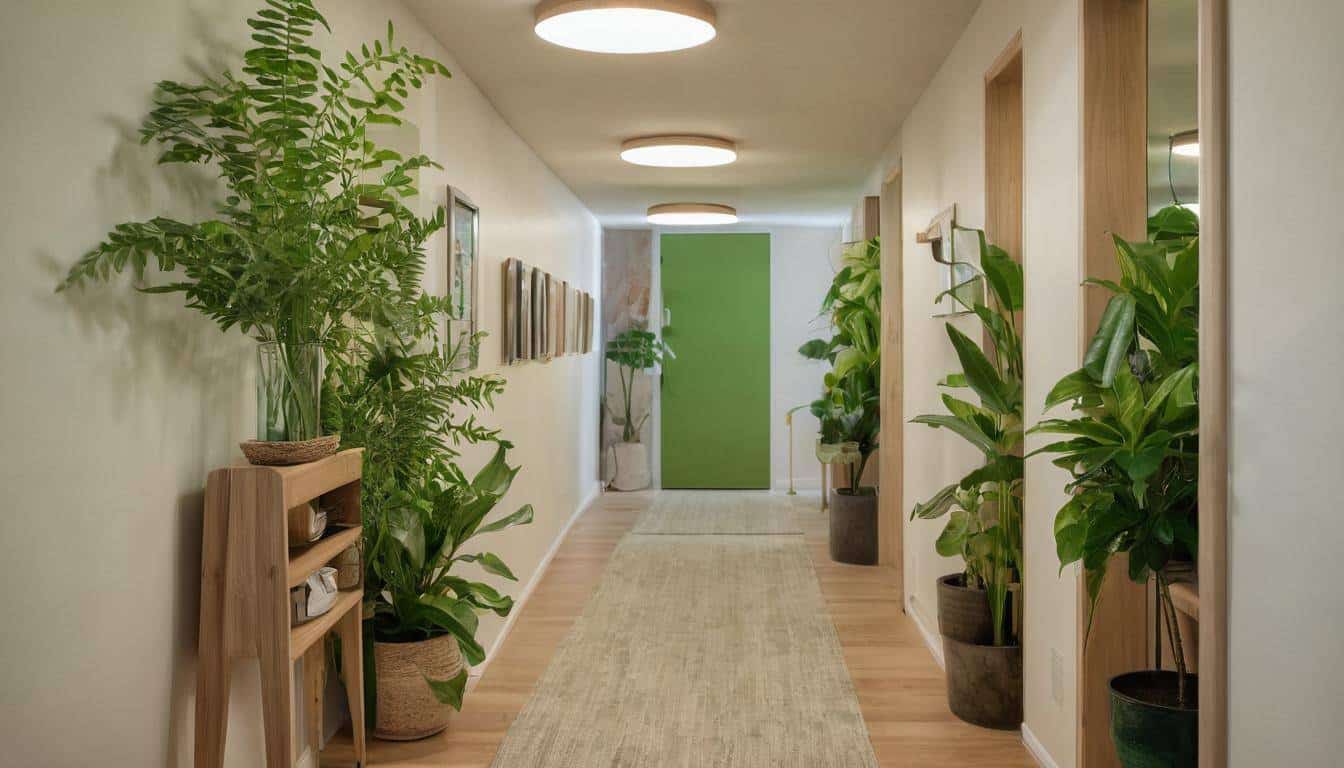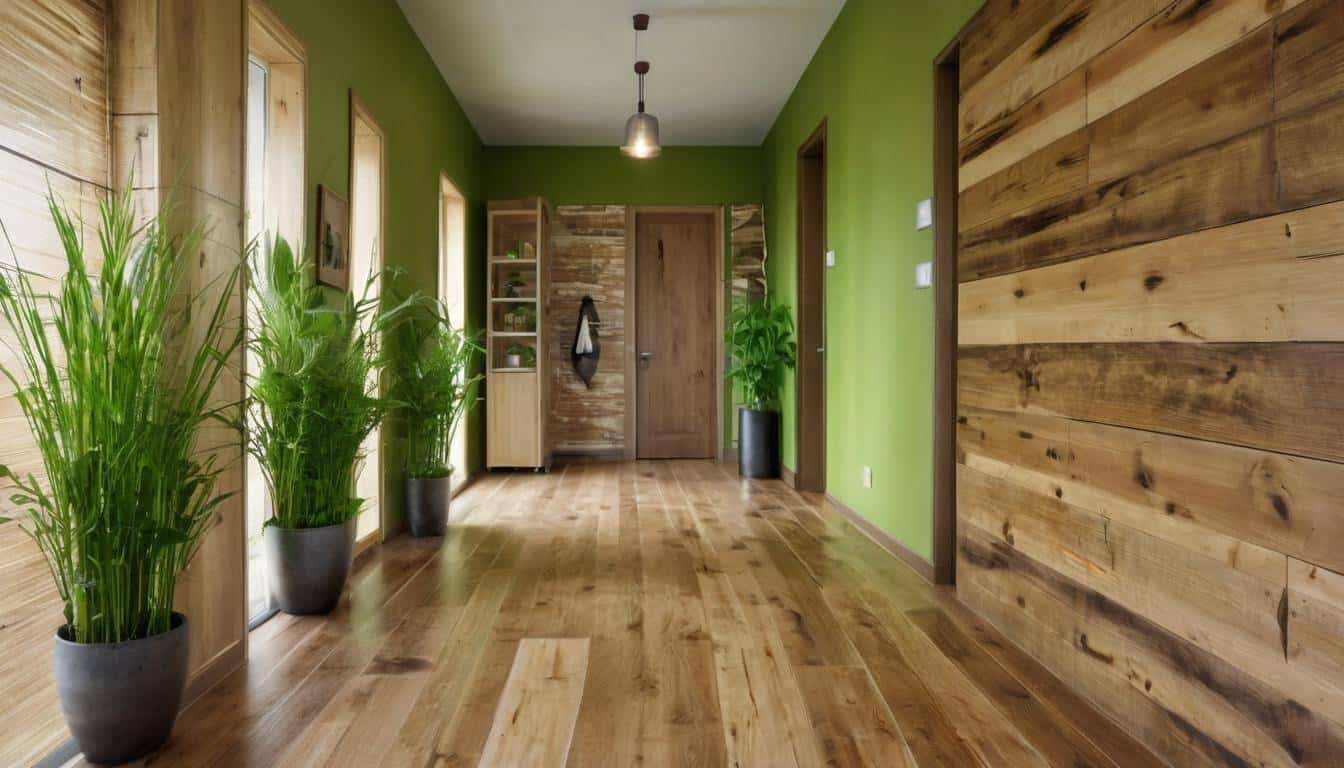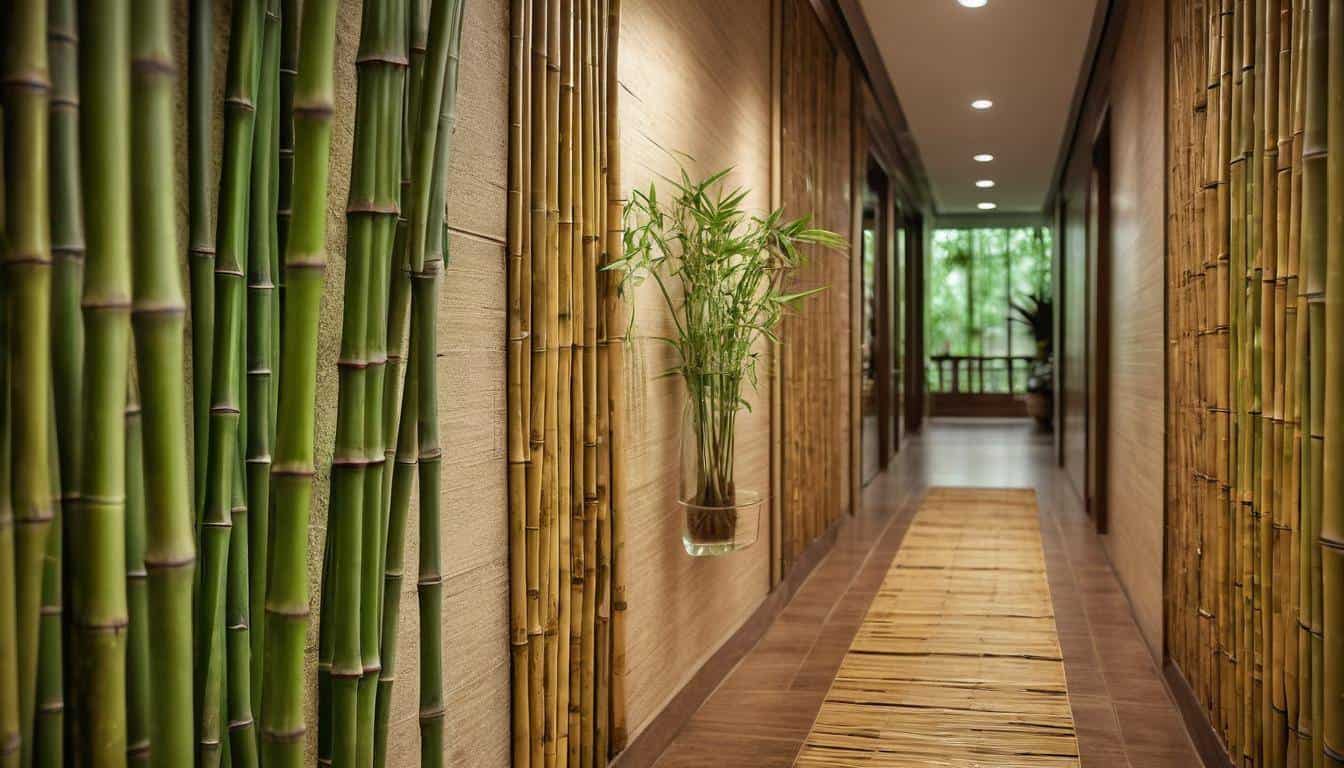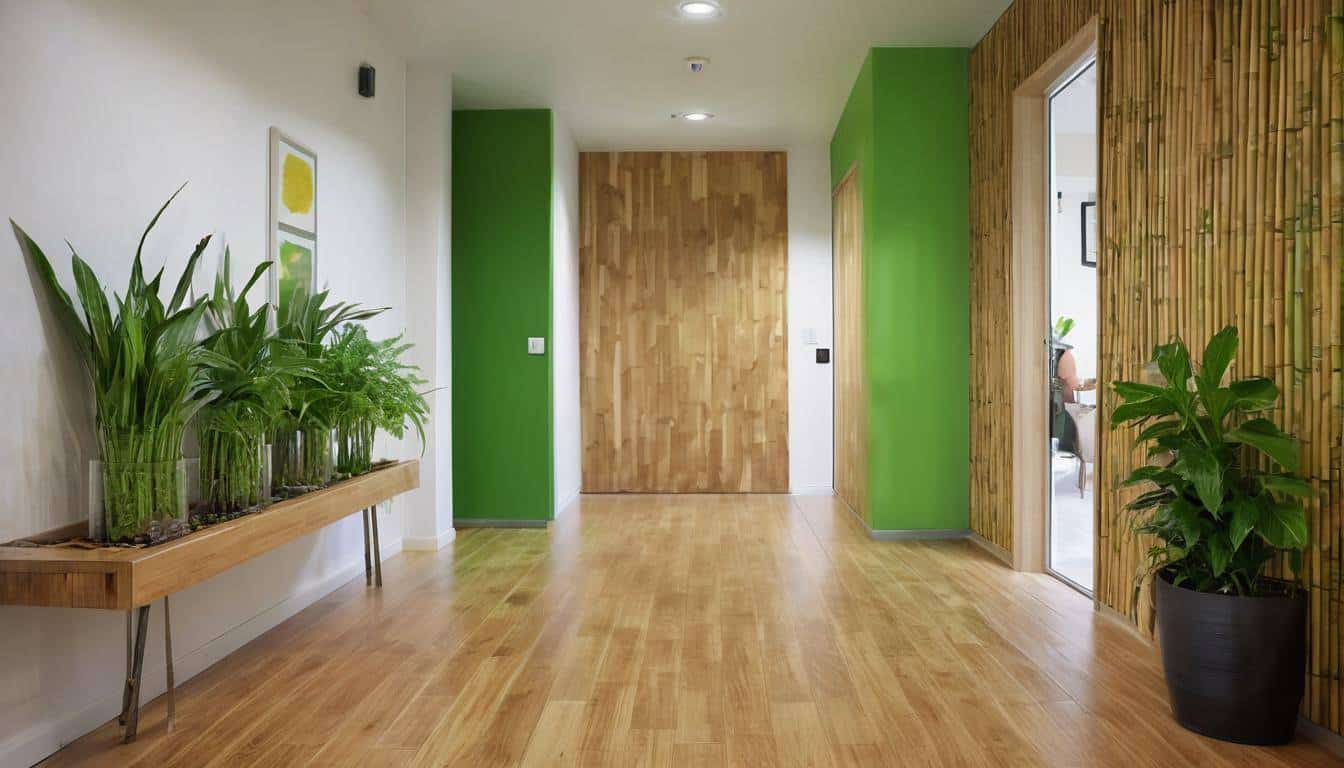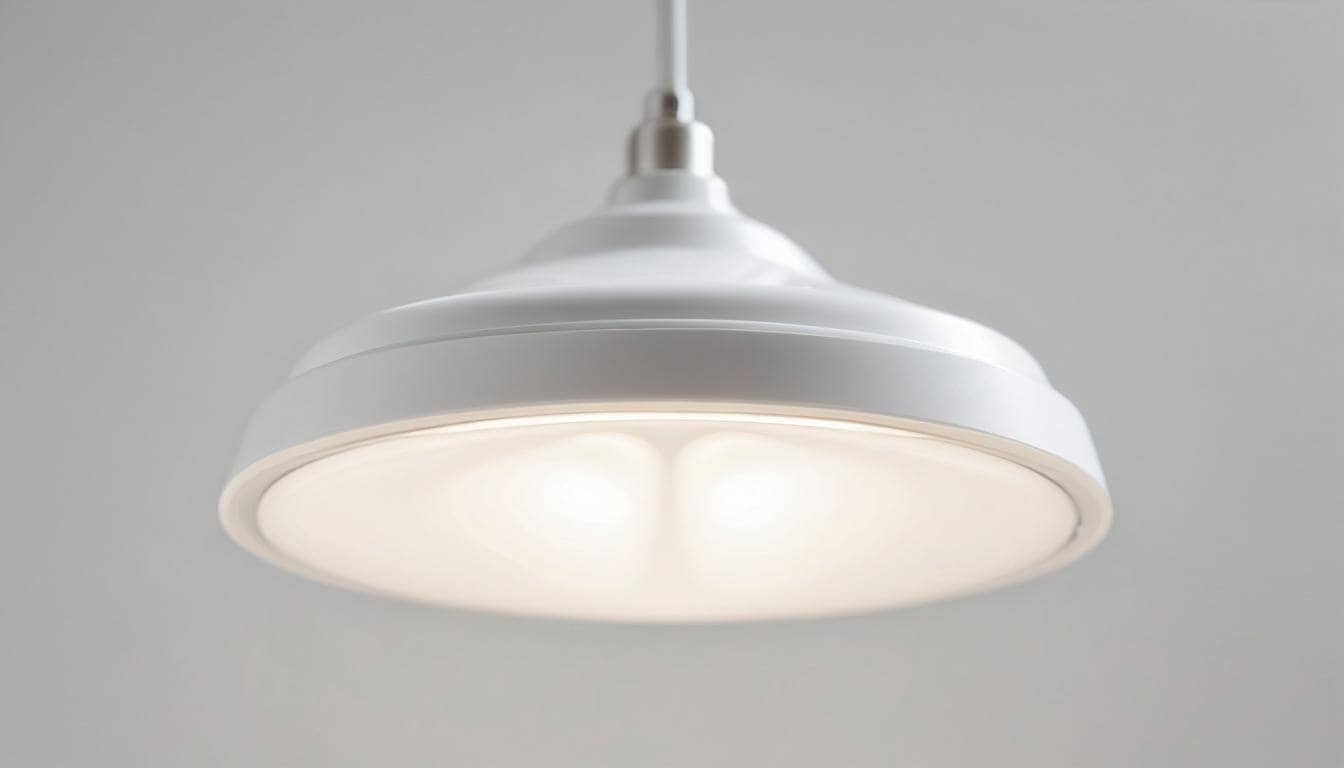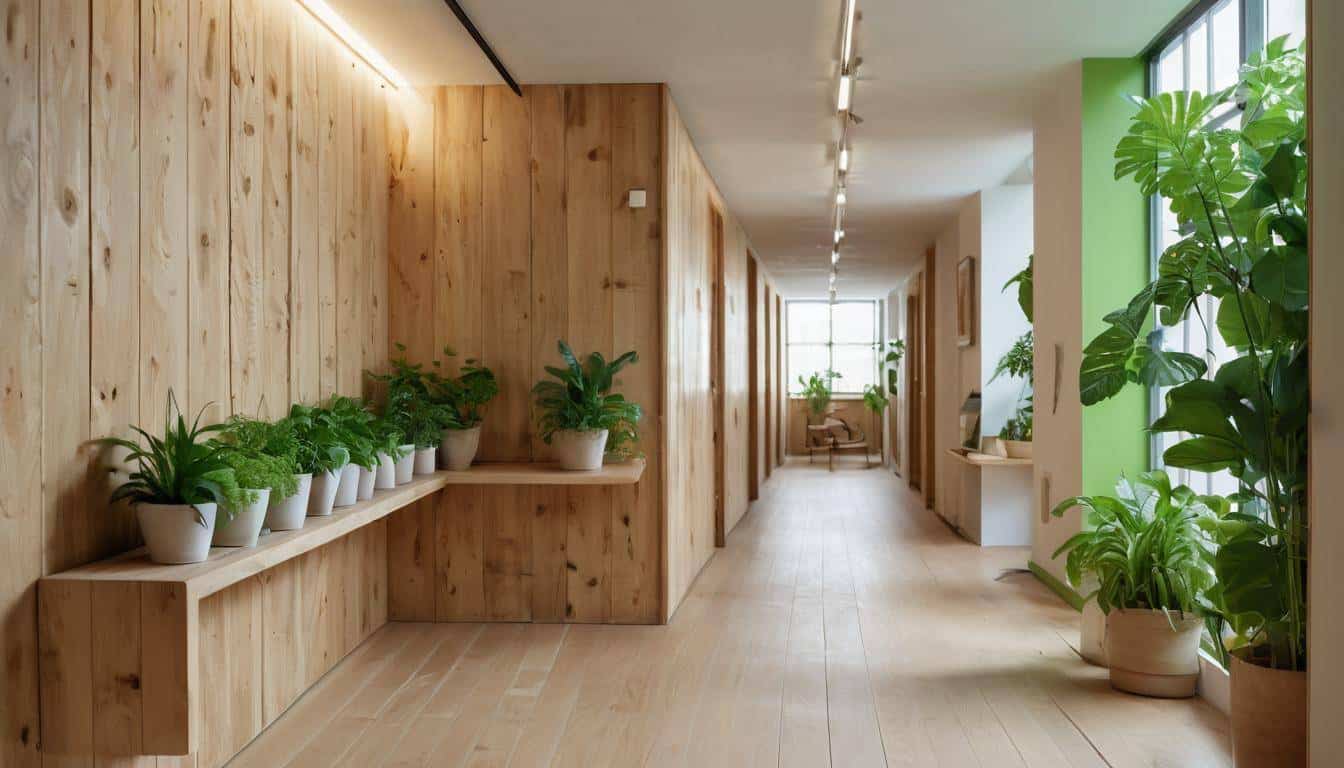Green hallways are an outstanding choice for your home. Not only do they help uphold our environment by using eco materials, but they also make your indoor air cleaner and lower your power bills. Imagine breathing in pure, chemically-untouched air in your very own hallway. Choosing earth-toned paints without harmful compounds adds to this purifying effect while giving your home a warm, rustic finish. This is like a double win where you save the world and improve your whole indoors feel at the same time. Now, let’s discuss these benefits further.
Decorating your hallway with a green color scheme can create a fresh and inviting atmosphere. Consider incorporating elements such as green accent walls, botanical artwork, and potted plants to bring a touch of nature indoors. Additionally, complement the green hues with neutral tones like white or beige for a balanced and harmonious look. This combination of green and neutral shades can transform your hallway into a serene and welcoming space.
Benefits of Green Hallways
Green hallways offer more than just aesthetic appeal; they provide several significant advantages for both the environment and our well-being. While green is a popular choice, other colors like yellow, grey, blue, and white can also create stunning and eco-friendly hallway designs.
Improved Indoor Air Quality
One of the most noteworthy benefits of green hallways is the impact on indoor air quality. By using eco-friendly materials like low-VOC (volatile organic compound) paints, natural fibers, and sustainably sourced wood, harmful emissions that degrade air quality can be minimized. Pollutants from conventional building materials can contribute to respiratory issues and allergies, while green alternatives promote a healthier living environment by reducing these harmful effects.
Plus, using natural ventilation through strategically placed windows or airflow systems encourages fresh air circulation, preventing stale and stuffy air from settling in your home.
Energy Efficiency
The incorporation of energy-efficient lighting fixtures and smart design features in green hallways can make a substantial difference in energy consumption. LED lighting, motion sensor-activated lights, and natural light via skylights or large windows contribute to lower energy usage. With LED lighting alone, average energy savings in green hallways can range from 50-75%, reducing both your carbon footprint and electricity bills.
In addition to lighting, green hallways also benefit from the implementation of eco-friendly plumbing fixtures. Water-saving faucets, toilets, and showers can significantly reduce water usage by 30-50%, conserving this precious resource while providing functionality and style.
Health and Well-being
Choosing green hallway designs positively influences mental and emotional well-being. The calming aesthetics and connection with the natural environment provided by sustainable materials create a tranquil space. Studies have shown that exposure to natural elements contributes to stress reduction and overall well-being, making green hallways a nurturing environment for all who pass through them.
Property Value
Integrating sustainable elements into your home’s design doesn’t just benefit your well-being; it also has tangible economic advantages. Properties with eco-friendly features are highly sought after and valued for their environmental consciousness and long-term cost savings. The use of sustainable materials and energy-efficient designs can significantly increase the overall value of the property, providing an attractive selling point for prospective buyers.
With a better understanding of how green hallways positively impact both our environment and our daily lives, let’s now explore another essential aspect of sustainable interior design—choosing eco-friendly paints.
Choosing Eco-friendly Paints
When it comes to creating an eco-friendly hallway, the type of paint you choose can make a significant difference. Opting for paints with low or zero volatile organic compounds (VOCs) is crucial in minimizing indoor air pollution. VOCs, found in many conventional paints, can emit harmful chemicals into the air, impacting indoor air quality and potentially causing health issues over time. By selecting paints with low VOC content, you not only contribute to a healthier indoor environment but also support sustainable practices that reduce harm to both human health and the planet.
It’s important to note that using low-VOC or zero-VOC paints does not mean sacrificing quality or variety. In fact, these eco-friendly paint options are now available in a wide range of colors and finishes. Whether you prefer bold and vibrant shades or soft, calming hues, there’s an eco-friendly paint to suit every design preference and style. From matte to glossy finishes, you can achieve the look you desire while prioritizing environmental responsibility.
For those seeking assurance about the eco-friendliness of their chosen paint, certifications such as Green Seal or UL Environment (UL GREENGUARD) are excellent indicators of low chemical emissions. These certifications assure consumers that the paint they’re using meets stringent standards for environmental responsibility, safety, and reduced chemical impact. When browsing for paints, keep an eye out for these certifications to guide your selection process toward more sustainable options.
Furthermore, considering shades of green or other earthy tones can significantly contribute to creating a cohesive eco-friendly aesthetic within your hallway. Earth-toned colors not only align with the sustainable theme but also evoke a sense of natural harmony and tranquility. These colors can create a soothing atmosphere while reinforcing the environmentally conscious design approach.
By choosing paints with minimal VOC content and seeking out reputable certifications like Green Seal or UL GREENGUARD, you’re making a conscious choice to prioritize health, sustainability, and aesthetic appeal in your eco-friendly hallway design.
Now equipped with a deeper understanding of how to integrate eco-friendly elements into your space, let’s delve into the implementation of natural accents that further enhance sustainability and aesthetic allure.
Implementing Natural Accents
Bringing the outdoors inside is a guaranteed way to create a sustainable and eco-friendly hallway. The incorporation of natural elements such as potted plants, reclaimed wood shelving, or bamboo flooring not only adds visual interest and texture but also connects your space with nature. Using these natural accents not only contributes to a greener environment but also sets a refreshing tone for anyone entering the hallway.
Potted Plants: Indoor plants can be more than just decoration; they can help improve air quality by reducing toxins and adding oxygen. They also have a calming effect, which can make the hallway feel more inviting. Choose low-maintenance plants like snake plants, pothos, or peace lilies, as these are great options for a high-traffic area like a hallway.
Reclaimed Wood Shelving: Using reclaimed wood for shelves is not only an environmentally friendly choice but also adds a touch of rustic charm to the space. It serves as a sustainable design solution that reduces waste and gives a unique character to your hallway.
Bamboo Flooring: Bamboo is a sustainable material that grows much faster than traditional hardwoods. It’s durable, easy to maintain, and creates a warm, natural ambiance in the hallway. Its versatility in design and eco-friendly properties make it an excellent choice for conscious homeowners.
By integrating these natural elements into your hallway design, you create a space that promotes wellness and sustainability. The beauty of these accents lies not only in their environmentally friendly nature but also in their ability to transform the hallway into an inviting and calming passage through your home.
As we journey from sustainable and eco-friendly design to maximizing utility without sacrificing aesthetics, let’s explore ingenious ways to make the most of your hallway space.
Space Maximization in Hallways
Often overlooked, hallways have the potential to be effective storage and display areas while serving as transitional spaces. When creating an environmentally conscious hallway, the goal is to optimize space use and ensure functionality without compromising on aesthetics.
To start, using minimalistic design principles can work wonders. Think sleek lines, compact furniture, and multifunctional storage solutions that serve a dual purpose while maintaining an eco-friendly ethos. For example, consider vertical wall space; installing narrow shelves or built-in bookcases allows for the display of plants or other sustainable decor items without encroaching on valuable floor space.
Furthermore, integrating nature into your hallway can provide a dual benefit. Not only do plants allow you to incorporate natural elements into your design, but they also contribute to improved air quality within your home. Additionally, choosing multipurpose furniture like storage benches ensures that the area remains clutter-free while providing additional functionality. Wall-integrated hooks can also serve as a practical and decorative solution for hanging bags, scarves, or hats – enhancing both form and function.
Remember, maximizing space in an eco-friendly hallway design requires a strategic approach. Make use of foldable furniture that can be compactly stored when not in use to free up precious floor space. Vertical gardens can be an innovative way to bring greenery into a limited area without sacrificing on aesthetics. Meanwhile, wall-mounted fixtures such as lighting or framed mirrors not only contribute to the overall design but also keep valuable floor space unobstructed.
In pursuit of environmentally friendly practices and sustainable living, it’s important to recognize that every element within your hallway serves a purpose beyond just decoration. By carefully integrating thoughtful design elements, you can create a space that not only maximizes its potential but also makes a positive impact on the environment.
Having established the importance of maximizing sustainability in hallway design, let’s now explore the materials best suited for creating eco-friendly and visually appealing hallways.
Sustainable Materials for Hallway Design
When it comes to designing a hallway sustainably, the materials you choose significantly reduce environmental impact and enhance the overall aesthetic. Opting for sustainable materials like reclaimed wood, bamboo, cork, and recycled glass contributes to creating an eco-friendly and visually appealing hallway.
Reclaimed Wood: Reclaimed wood is an excellent choice for hallway flooring and wall coverings. This sustainable material not only adds warmth and character to the space but also minimizes the demand for new wood resources. By repurposing wood from old structures such as barns or warehouses, you’re contributing to environmental conservation while introducing a sense of history and uniqueness to your hallway design.
Bamboo: Bamboo is renowned for its sustainability and durability, making it an ideal option for flooring in high-traffic hallways. It grows rapidly and matures quickly, allowing for efficient harvesting without causing long-term damage to the environment. Additionally, bamboo offers a distinct visual appeal with its natural grain patterns, adding an organic touch to the hallway decor.
Cork: Cork is a versatile and eco-friendly material that can be used for flooring or wall coverings in hallways. Harvested from the bark of cork oak trees, this renewable resource regenerates over time, ensuring minimal ecological impact. Cork also provides acoustic insulation and resilience underfoot, enhancing both the sustainability and functionality of the hallway space.
Recycled Glass: Utilizing recycled glass in decorative elements or as part of wall coverings offers a creative and eco-conscious approach to hallway design. Repurposing glass reduces energy consumption required for manufacturing new glass products, effectively decreasing carbon emissions. Moreover, recycled glass adds visual interest through its varied textures and colors, contributing to an environmentally conscious yet stylish ambiance in the hallway.
By integrating these sustainable materials into your hallway design, you not only contribute to environmental conservation but also create a distinctive atmosphere characterized by texture, color diversity, and visual appeal. Each material tells a story of sustainability and responsible design while elevating the overall aesthetic of the space.
With these sustainable materials at your disposal, your hallway can exude a harmonious blend of elegance, functionality, and eco-friendliness. The footprint of your design choices extends beyond aesthetics, leaving a positive impact on both the environment and occupants alike.
Energy-Saving Tips for Green Hallways
When it comes to making your hallways more eco-friendly, there are several measures you can take to reduce energy consumption and minimize environmental impact without sacrificing style or comfort. Let’s explore three key strategies for achieving an energy-efficient hallway.
Use Energy-Efficient Lighting
One of the most impactful ways to lower your hallway’s energy use is by replacing traditional light fixtures with LED bulbs. LED lights are highly efficient, using 75% less energy than incandescent lighting and lasting 25 times longer. This not only reduces electricity bills but also minimizes the need for frequent bulb replacements, contributing to less waste over time.
Moreover, consider implementing motion-sensing or timer-controlled lights. Motion-sensing lights automatically turn on when someone enters the hallway and shut off shortly after they leave. On the other hand, timer-controlled lights enable you to program specific operating schedules, ensuring that lights are only in use when needed, leading to significant energy savings.
Harness Natural Light
Natural light is a valuable resource that can be harnessed to reduce the reliance on artificial lighting within your hallway. Consider using sheer or light-filtering window treatments to maximize the entry of natural light while minimizing glare and heat gain. These treatments provide privacy while allowing daylight to permeate the space, creating a warm and inviting atmosphere without the need for excessive electrical illumination during the day.
Install Smart Thermostats
Integrating smart thermostats into your home’s heating and cooling system can play a crucial role in optimizing energy usage throughout the entire property, including the hallway. Smart thermostats offer precise control over temperature settings, enabling automatic adjustments based on occupancy patterns and personalized schedules. By efficiently managing heating and cooling operations, smart thermostats minimize energy waste, reduce utility costs, and contribute to a more sustainable living environment.
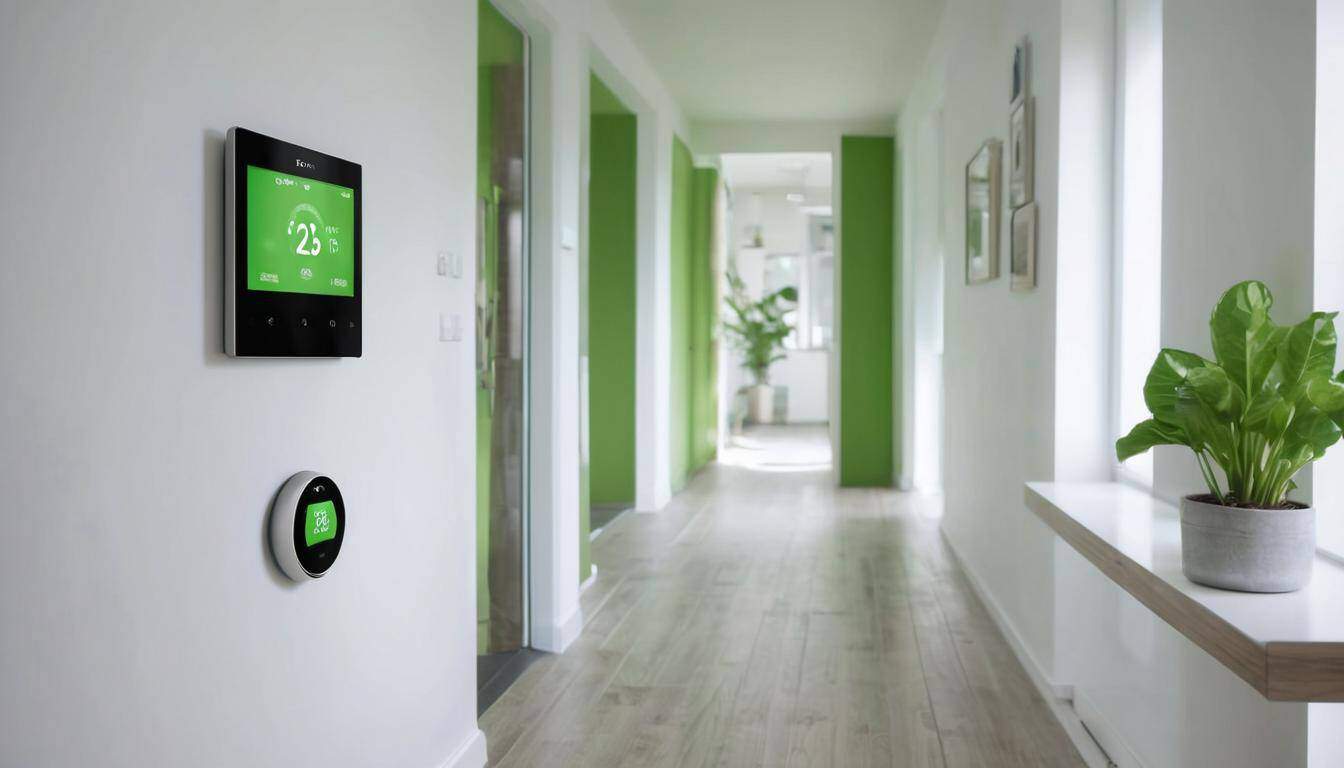
By incorporating these energy-saving tips into your hallway design, you can create a space that not only promotes sustainability but also offers long-term cost savings and environmental benefits. If you’re seeking further inspiration and ideas for eco-friendly hallway design, feel free to explore our website at Amazing Home Decor Co.
Embracing eco-friendly practices in your home not only benefits the environment but also enhances your living space with a sense of conscientious design and long-term practicality.

